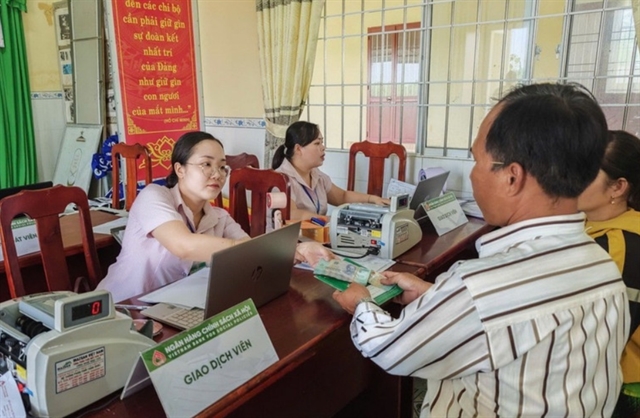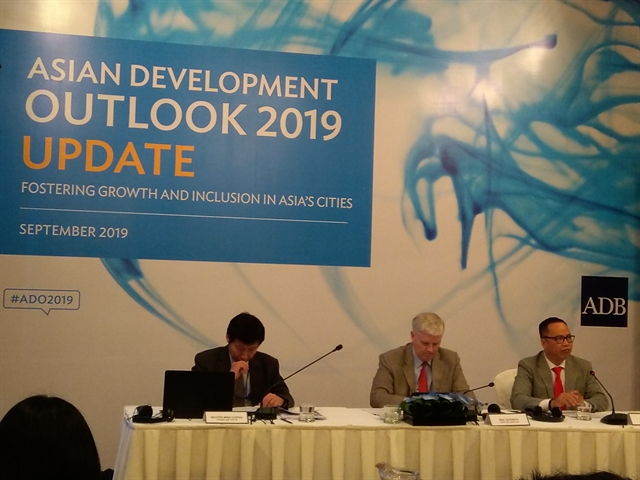 Economy
Economy


|
| ADB representatives at the report launch on Wednesday. The bank retained its growth forecasts for Việt Nam at 6.8 per cent in 2019 and 6.7 per cent in 2020. — VNS Photo Mai Hương |
HÀ NỘI – The Asian Development Bank (ADB) forecasts a moderate deceleration for Việt Nam’s growth this year and next, but says Việt Nam is still a standout in Asia with stable development thanks to resilient domestic demand and sustained inflows of foreign direct investment (FDI).
In its Asian Development Outlook 2019 Update released on Wednesday, the bank retained its growth forecast for Việt Nam at 6.8 per cent in 2019 and 6.7 per cent in 2020, after exceptionally high growth of 7.1 per cent last year.
Việt Nam’s growth prospect outperformed ADB’s projection for the average growth of developing economies in Asia (excluding Hong Kong, Taiwan, Singapore and Republic of Korea), which was revised down from 5.7 per cent to 5.4 per cent in 2019, and 5.6 per cent to 5.5 per cent in 2020.
Forecasts for average inflation have been revised down to 3 per cent from 3.5 per cent for 2019, and to 3.5 per from 3.8 per cent for 2020.
“Despite a slowdown in export growth due to the escalation of the trade conflict between the United States and the People’s Republic of China and the consequent downturn in global trade, the Vietnamese economy remains healthy thanks to continued strength in domestic demand and sustained inflows of foreign direct investment,” said ADB Country Director for Vietnam Eric Sidgwick.
Việt Nam’s GDP grew 6.8 per cent in the first half this year, slightly down from 7 per cent in the corresponding period of last year. Exports of goods and services slowed by more than half, from 15.7 per cent in the first six months of 2018 to 7.1 per cent this year, due to weakened external demand.
However, the adverse effect of the export slowdown was cushioned by continued strength in domestic demand. Private consumption expanded 7.2 per cent in the first half this year, the same rate as a year earlier. Meanwhile, domestic investment grew 7.1 per cent, bolstered by an improved business environment, strengthened investor confidence and strong FDI inflows.
“[The] prospect for domestic consumption continues to be positive, supported by rising incomes, buoyant employment and moderate inflation,” Sidgwick said.
The report also upheld continued government efforts to improve the business environment, along with recent upward revisions to sovereign credit ratings, would spur both private and foreign investment.
If the US-China trade conflict continued to escalate, more manufacturers may consider Việt Nam as an alternative base, providing fresh impetus to FDI inflows, it said. Additionally, the regional Comprehensive and Progressive Agreement for Trans-Pacific Partnership (CPTPP) and the recent signing of the free trade agreement with the European Union promised to further open market access for trade and investment.
“FDI inflows should therefore continue to be strong in the near term, as evidenced by US$13.1 billion in FDI commitments in the first eight months,” it said.
Nguyễn Minh Cường, principal country economist for Việt Nam at ADB, noted foreign capital had been pouring into domestic companies with foreign equity contributions rising 80 per cent this year.
“It’s strong growth, indicating there may by a shift in foreign investment due to the impact of the US-China trade conflict. But we need more time to see the level of displacement and places where foreign capital is located, whether it runs into high quality, value added or labour intensive sectors,” Cường said.
Dim outlook for agriculture
In the first half, all sectors witnessed slower growth but agriculture fell hardest.
Prolonged drought and a fresh outbreak of African swine fever dragged growth in agriculture down from 3.8 per cent in the first half of 2018 to 2.4 per cent this year.
The agriculture sector was important in Việt Nam, not in terms of its contribution to growth but its social impact, especially on farmers, Sidgwick said.
“They [farmers] are worrying a lot more about farm production which is being affected by issues related to climate change… They find it hard to predict the weather; extreme weather such as floods and droughts make their lives much more difficult.”
Cường said Việt Nam was doing well to diversify its export markets but suggested farmers applied advanced technology in agriculture and improve product quality as the demand from consumers for safe products was rising and many countries were employing high safety standards as non-tariff barriers.
Meanwhile, the outlook for industry and services remained positive, according to the report.
The manufacturing purchasing managers’ index remained above 50 in the first eight months, which bodes well for the industry. Services are seen to continue growing with further expansion in retail and wholesale trade to meet buoyant demand and higher tourist arrivals, assuming they reach the target of 15 million by year-end.
The report also highlighted significant risks to the forecast. Further escalation of the US–China trade tensions and the continuing global economic slowdown could shrink global trade, which would adversely impact Việt Nam’s trade performance and economic growth.
“Việt Nam has done very well but looking ahead, I think the risk is much higher than it has been and continued resilience is required, but I think the Vietnamese Government is well aware of that,” Sidgwick said.
In the middle of this month, the ASEAN+3 Macroeconomic Research Office (AMRO) also released its forecast for Việt Nam’s growth, which it expected to expand 6.6 per cent in 2019. — VNS



